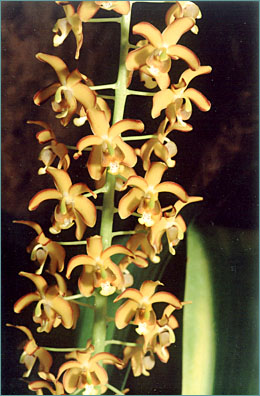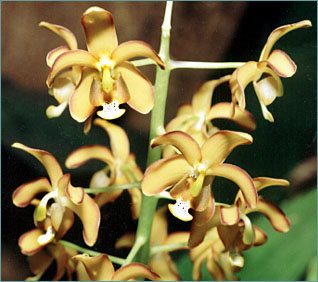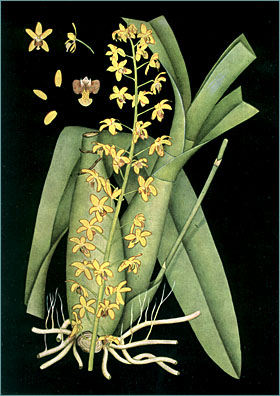|
|
| by Delfina de Araujo |
Tribe: Cymbidieae Subtribe: Cyrtopodiinae Etymology: With aspect of or similar to the genus Eria. It is a Greek word and means appearance, similarity. Synonym: Pseudoeriopsis Rcbh. f (l849) Species considered as valid : Eriopsis biloba and Eriopsis sceptrum Occurrence in Brazil: Both. |
| This
genus has been described by Lindley in l847 and appears since Costa Rica
until Brazil and Peru. Although there are at about twelve different descriptions, just two are nowadays considered valid: Eriopsis biloba and Eriopsis sceptrum, the first one is terrestrial and rupicolous and the second, epiphyte. G. F. Pabst & F. Dungs (in Orchidaceae Brasilienses) considered both as epiphyte and both belonging to province 2, it means, as occurring at lowlands. However, the registers did not confirmed the information that Eriopsis biloba nor occurs at sea level neither being epiphyte. Recently, João Batista F. da Silva, in his researches through the Amazon region, has the opportunity of documenting many occurrence of those species: Eriopsis biloba always in altitude and Eriopsis sceptrum at the sea level until 150m altitude. This genus has elongated and smooth pseudobulbs, in general, they are hollow inside. The petals and sepals vary in yellow-hued and reddish-chestnut shaded at the margins. The lip is carineted in the longitudinal sense and has two horns at the disc. The raceme emerges from the axils of the both sides of the pseudobulbs dispersal multiflora with showy, medium and pedicelated flowers e with relativity small sheaths Concerning the cultivation, F. C. Hoehne says em "Flora Brasilica 10 Vol. XII, VII": “... very vigorous plant but with special requirements to be cultivated under cooler climate”. However by more recent reports, we concluded that Eriopsis biloba needs temperate to cool climate and Eriopsis sceptrum needs hotter or temperate climate. Both species can be cultivated in shade places or receiving higher luminosity but they need protection the their roots in order not to receiving insolation. They requiring high humid environment and, specially, until the pseudobulbs are completely developed. The roots have to be always moist. |
| Eriopsis
biloba Lindley has been described in l847, based in a plant found in
Peru. It occurs in Belize, Costa Rica, Colombia, Guyanas, Honduras, Ecuador, Nicaragua, Panama, Peru, Venezuela and Brazil (in the states of Amazonas and Roraima). It is supposed that it is also occurs in the state of Pará. This plant appears in different altitude zone: in Colombia, it has been found at 125m and 1.310m; in Belize, from 500 to 600m; in Venezuela, a 700m, from 900 to 1000m, at 1550m and from 1750 to 1850 m; in Costa Rica, at 400m; in Panama, from 800 to 1000m. João Batista F. da Silva, in his article: "Viajando pela Amazônia – II . Serra do Surucucu e Cordilheira Parima" (Traveling through Amazon region. II. Surucucu mountain and Parima Cordillera (magazine Caob) and in interview by telephone, confirms the occurrence of this plant in Caburaí and Surucucu moutains,in Roraima and informs that it is easy to differentiate this species from Eriopsis sceptrum, which occurs in the igapós of the rivers of the state of Amazonas, because it does not have aerial secondary roots. He found it vegetating as rupicolous on rock, in place with small vegetation, in altitude varying from 1.100 to 1500 m, Caburaí mountain. He also found it in clearing, so in more open place, with much more sunstroke, always in swampy soil, even vegetating in the mud. |
 |
| However,
in Parima mountain, it vegetates in very dry soil. Surucucu mountain, in Roraima, he verified the occurrence on rocks but in shade place, inside the bushes and in opened vegetation, sheltered by the shrubs, and surrounded by the Clusias, Melatosmatacea. Under any circumstances, the root never receives insolation, it is always well protected. Where the luminosity is strong, the humidity is higher. The occurrence of this species in Brazilian territory is more rare mainly when compared to other species which has a wider distribution. |
 |
The
oblong-conical pseudobulbs are vigorous and vary from 15 to 20 cm high and
from 3 to 6 cm diameter. It presents two leaves varying from 20 to 30 cm long and from 4 to 6 cm wide and they born from the apex of the pseudobulb. The inflorescence is erect and has from 40 to 60 cm long, emerging from the base of the pseudobulb and presenting small sheaths The blooming time extends from December until August. The flowers have distended segments, the petals and sepals vary from orange yellow to brownish yellow, reddish chestnut shade at the margins. The scent reminds the perfume of melon. The sepals have from 11 to 14 mm long and 5-6 mm wide. The petals vary from 10 to 13 mm long and 3.5-4.5 mm. |
| The
lip is white, chestnut spotted and dark brown at the base and it is a little
shorter than the petals and are larger than long (10-12 x 13-16 mm). Synonyms: Eriopsis colombiana Schltr. Eriopsis fuerstembergii Krzl. Eriopsis grandibulbosa Ames & Schweinf. Eriopsis mesae Krzl. Eriopsis rutidobulbon Lem. Eriopsis schomburgkii Rchb. f. Eriopsis wercklei Schltr. Pseuderiopsis schomburgkii Rchb. f. |
| It was described in 1854 and, in l861, Reichbach f has
described it again under the name of Eriopsis sprucei. It occurs
in Ecuador, Guianas, Peru, Venezuela, in Brazil, it appears in the states
of Amazonas and Roraima. It is found since 80 until 470m in Venezuela. In Ecuador, at 190 m at 265 m. In Brazil, since 40 to 150m. |
 |
Very
vigorous plant, forming clump with 50cm diameter. The pseudobulbs have at
about 20-25cm high by 3-6cm diameter. It bears, in general, 2 leaves but
it can also have 4, from 40 to 70cm long by 4.5-6cm wider. It has a clump
of pneumatophore roots it means, they have erect, acute and spongy tips.
It bears erect racemose inflorescence with 50 to 80cm high. The dorsal sepal
is 14-15mm longer by 6mm wider, the lateral ones are a little shorter with
12-14mm by 7mm wider. The petals are 12-13mm longer by 5-5,5mm wider. The
flowers are lemon-yellow and red shaded at the margins. The lip is as wider
as longer (11-12mm x 11-12mm or 12-13 mm x 12-13mm), and purple and white
spotted. João Batista registered the occurrence at Tefé Lake (Amazonas, near to Solimões river). Alongside of Japurá river, he found trees of thousands plants and also next to Manaus, in altitude at about 40m. Alongside of Aracá river, he found big clumps. Alongside of Yauapery river, in Roraima, in altitudes |
|
a little higher, at about 130, 150m. Alongside of this river, Barbosa Rodrigues
found this same plant and described it as Cyrtopodium yauaperyense.
F. C. Hoehne (in Iconografia de Orchidaceas do Brasil) described the travel he did in direction of Santarém and then Belém, going up the Tapajós river, he talks about this plant saying that: in old trunks, at the edges of small lagoons, appear enormous clumps of Eriopsis sprucei (synonym))”. However, the later literature doesn't mention the state of Pará as its habitat. João Batista F. da Silva, in his article "Viajando pela Amazônia. I. Rio Aracá (AM)"(Traveling through Amazon region I. Aracá River- AM) says: ”... the more we go up the river, bigger is the concentration of orchids, as the enormous clumps of Eriopsis sceptrum... In April, the period of flood starts, in May, the inundation penetrates the igapó forest and from June to August, when the river is at the maximum level of flood, the tapiris (shanties) built at the margins, remain totally covered by the water, uninhabitable...” So, as the precedent, it always occurs in high humid environment. Synonyms: Cyrtopodium yauaperyense Barb. Rodr. Eriopsis helenae Krzl Eriopsis sprucei Rchb. f. |
| Bibliography: |
Any
kind of reproduction (print, digital or anyone other) of any type
of material of this site - texts, layout, photos, images and others - is strictly forbidden without the previous written permission of the authors. Any information should be done by the e-mail: bo@sergioaraujo.com |